 |
||
|
HOME
|
US Navy -
ships
|
US Navy - air
units
|
USMC - air
units
|
International
Navies
|
Weapon Systems
|
Special Reports |
||
|
US Navy - Guided Missile Destroyer DDG 66 - USS Gonzalez |
||
|
||
| 02/20 | ||
|
Type,
class: Guided Missile Destroyer - DDG; Arleigh Burke
class, Flight I Builder: Bath Iron Works, Bath, Maine, USA STATUS: Awarded: January 16, 1991 Laid down: February 3, 1994 Launched: February 18, 1995 Commissioned: October 12, 1996 IN SERVICE Homeport: Naval Station Norfolk, Virginia Namesake: Sergeant Alfredo Cantu Gonzalez (1946 - 1968) Ships Motto: BEYOND THE CALL Technical Data: see: INFO > Arleigh Burke class Guided Missile Destroyer - DDG |
||
| images | ||
 returning to Naval Station Norfolk, Virginia - October 2019  Red Sea - April 2019  Souda Bay, Greece - April 2019  Souda Bay, Greece - April 2019  Naval Station Rota, Spain - March 2019  departing Naval Station Norfolk, Virginia - March 2019  Atlantic Ocean - February 2019 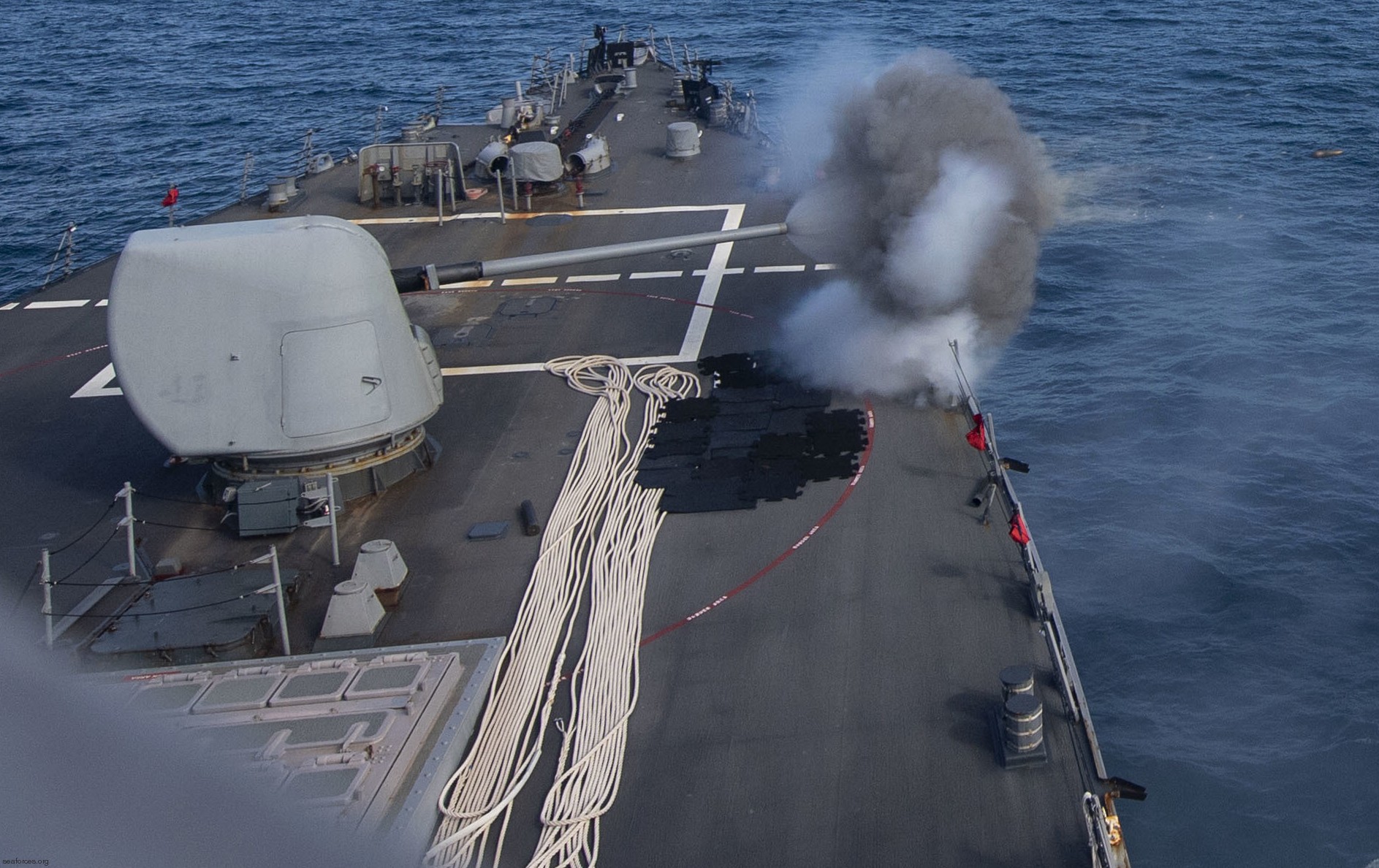 Mk-45 Mod.2 5" main gun fire exercise - Atlantic Ocean - February 2019  Mk-38 Mod.2 machine gun fire exercise - Atlantic Ocean - February 2019  Mk-45 Mod.2 5" main gun live-fire exercise - Atlantic Ocean - November 2018 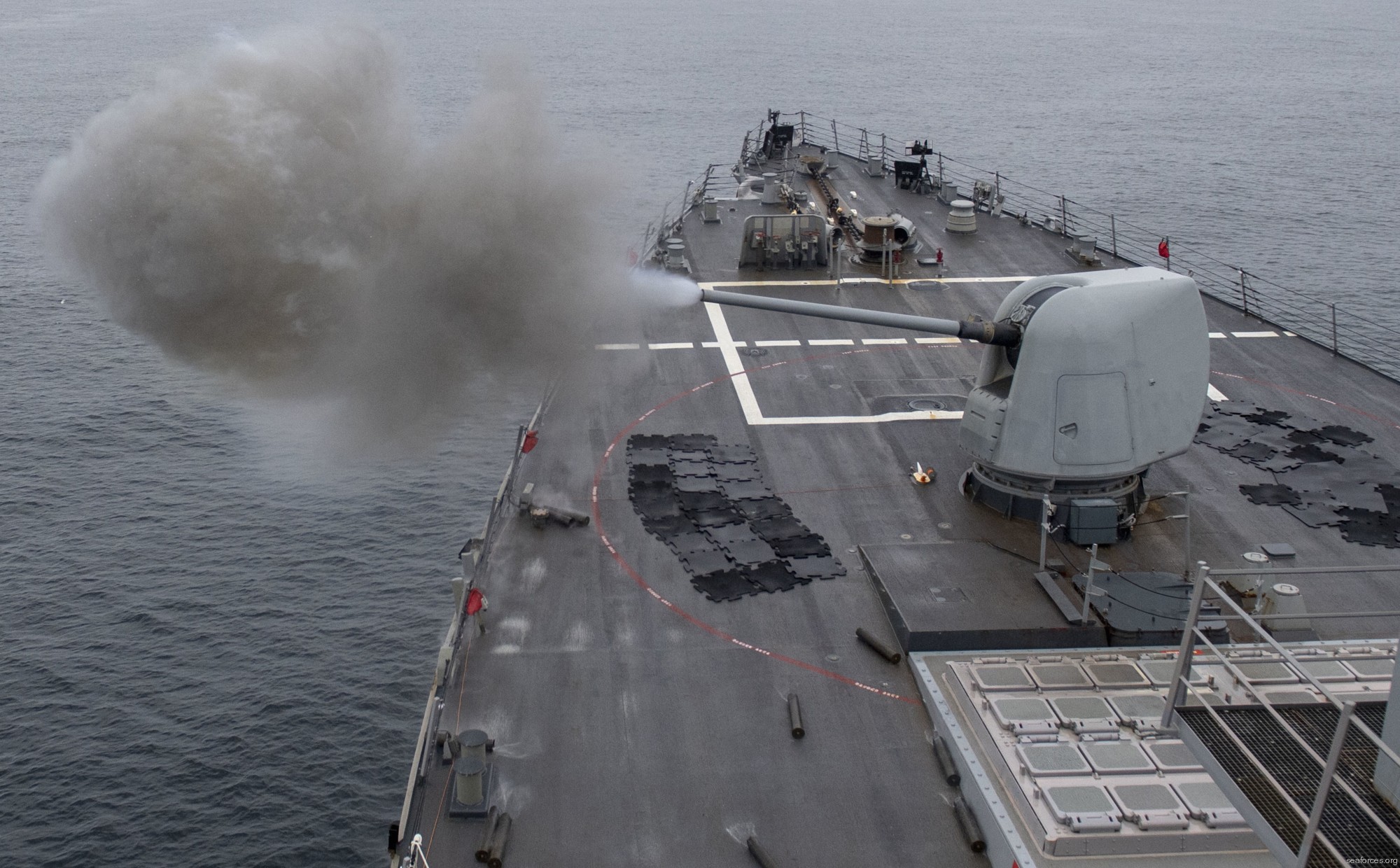 Mk-45 Mod.2 5" main gun live-fire exercise - Atlantic Ocean - November 2018  Combat Information Center (CIC) during Surface Warfare Advanced Tactical Training exercise (SWATT) - Caribbean Sea - November 2018  Bridge/Helm during Surface Warfare Advanced Tactical Training exercise (SWATT) - Caribbean Sea - November 2018  Combat Information Center (CIC) - Sonar space - during Surface Warfare Advanced Tactical Training exercise (SWATT) - Caribbean Sea - November 2018  Mk-38 Mod.2 25mm machine gun preparations during Surface Warfare Advanced Tactical Training exercise (SWATT) - Caribbean Sea - November 2018  arriving at Naval Station Norfolk, Virginia - October 2018  departing Naval Station Norfolk, Virginia - September 2018  departing Naval Station Norfolk, Virginia - September 2018  with Italian Navy Frigate ITS Alpino (F 594) - Atlantic Ocean - May 2018  arriving at Naval Station Norfolk, Virginia - July 2016  Souda Bay, Greece - June 2016 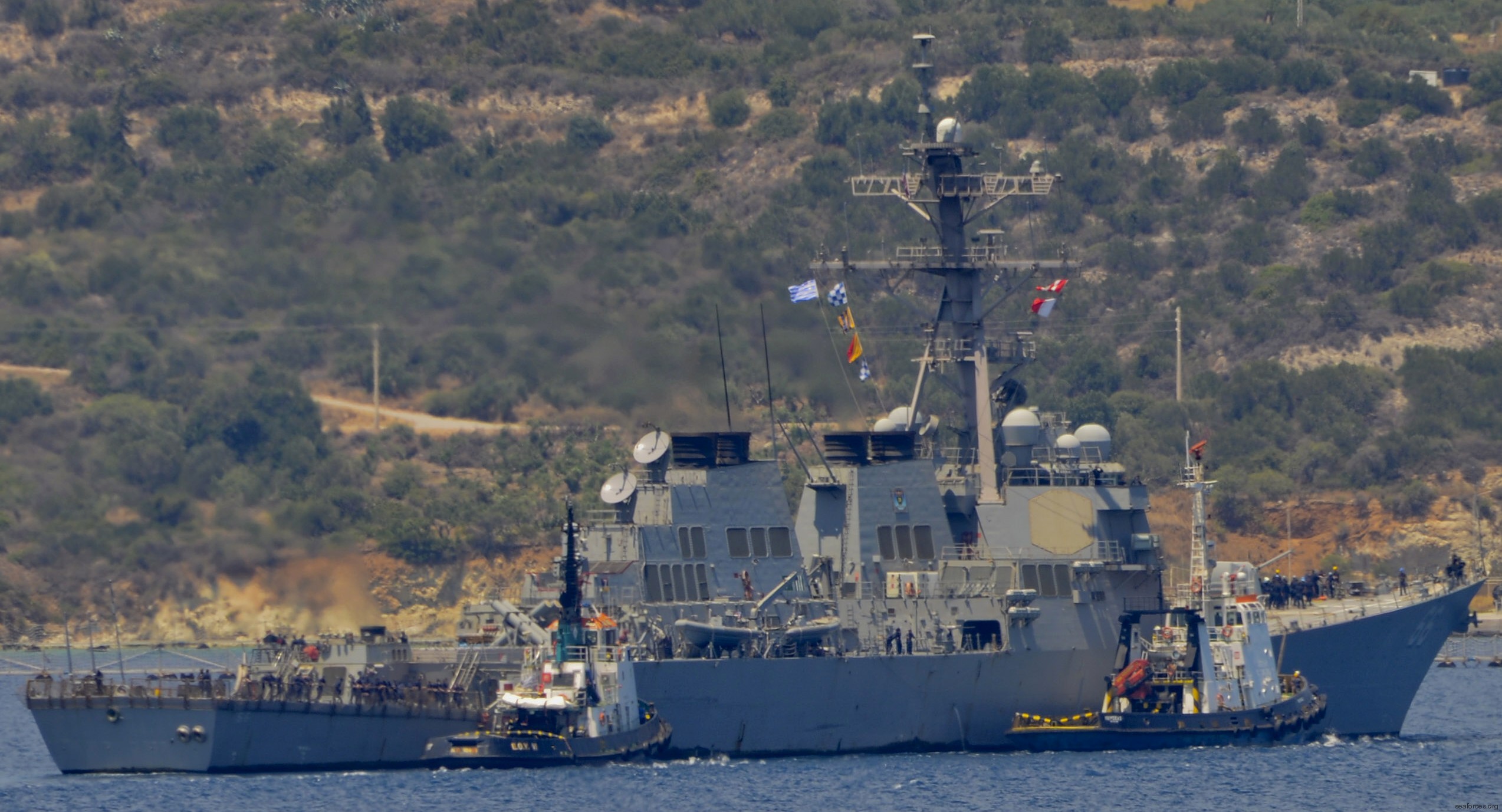 Souda Bay, Greece - June 2016  Suez Canal - June 2016  Gulf of Aden - May 2016  Mk-45 Mod.2 gun live-fire exercise - Gulf of Aden - May 2016  Gulf of Oman - April 2016  Indian Ocean - January 2016  Arabian Sea - December 2015  Mediterranean Sea - December 2015  Atlantic Ocean - November 2015  a SM-2 Standard Missile was launched from the forward Mk-41 VLS - Atlantic Ocean - June 2015 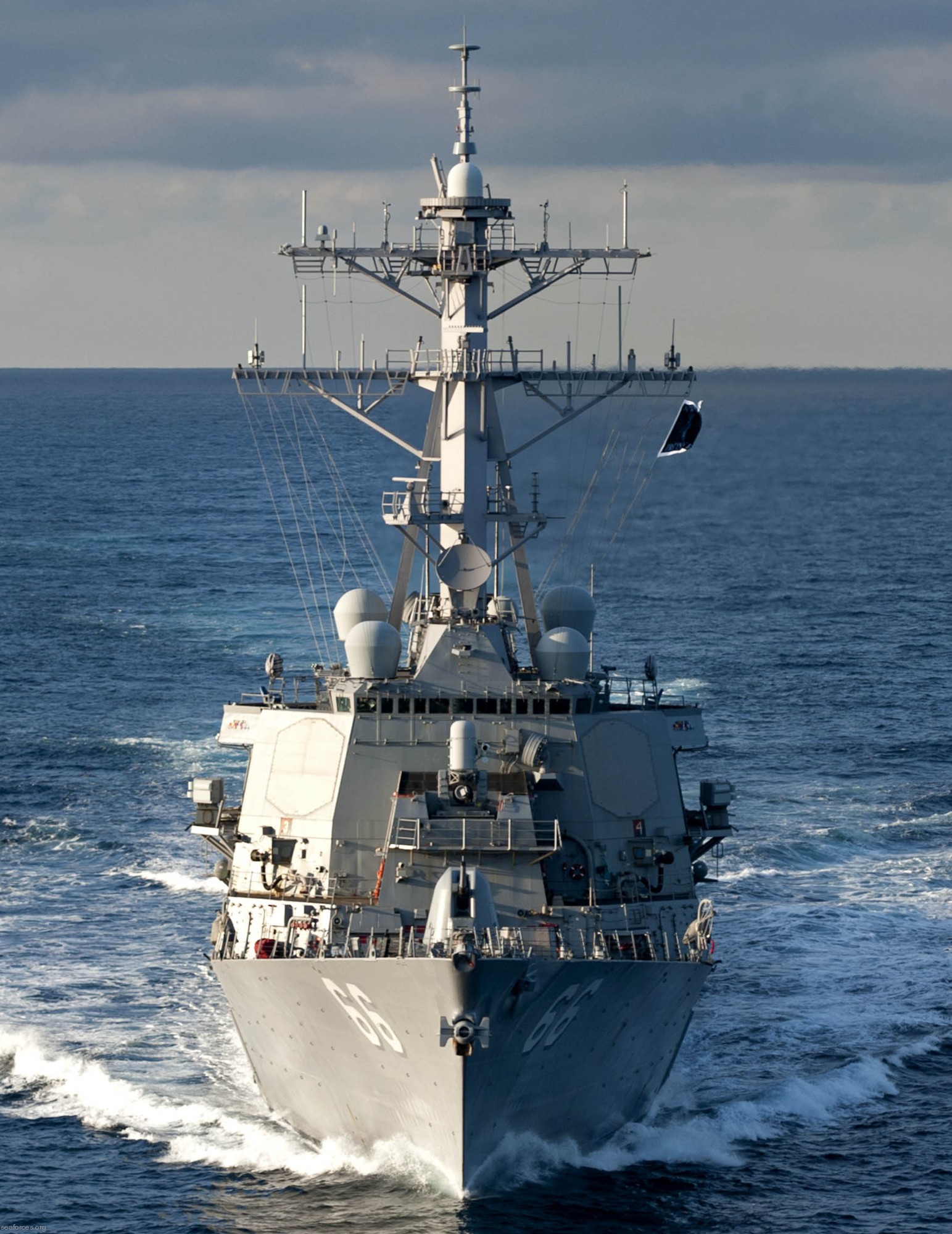 Atlantic Ocean - March 2015  departing Naval Station Norfolk, Virginia - January 2013  Souda Bay, Greece - July 2008  Souda Bay, Greece - July 2008  Souda Bay, Greece - June 2008  Souda Bay, Greece - June 2008  Souda Bay, Greece - July 2006  Souda Bay, Greece - July 2006  Persian Gulf - February 2006 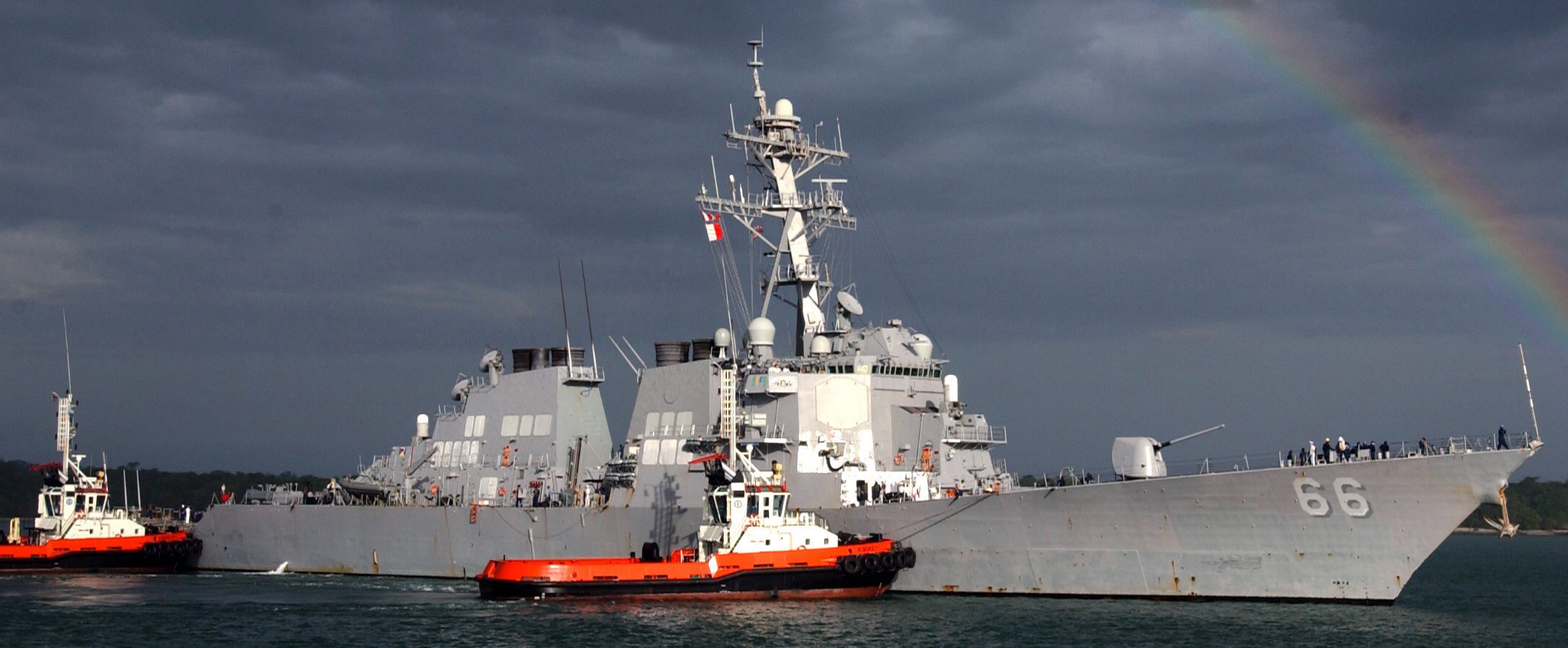 Mombasa, Kenya - July 2005  Mediterranean Sea - April 2004  Souda Bay, Greece - January 2004  Bar, Montenegro - December 2003  Bar, Montenegro - December 2003  Atlantic Ocean - September 2003  a BGM-109 Tomahawk missile was fired during Operation Allied Force - March 1999 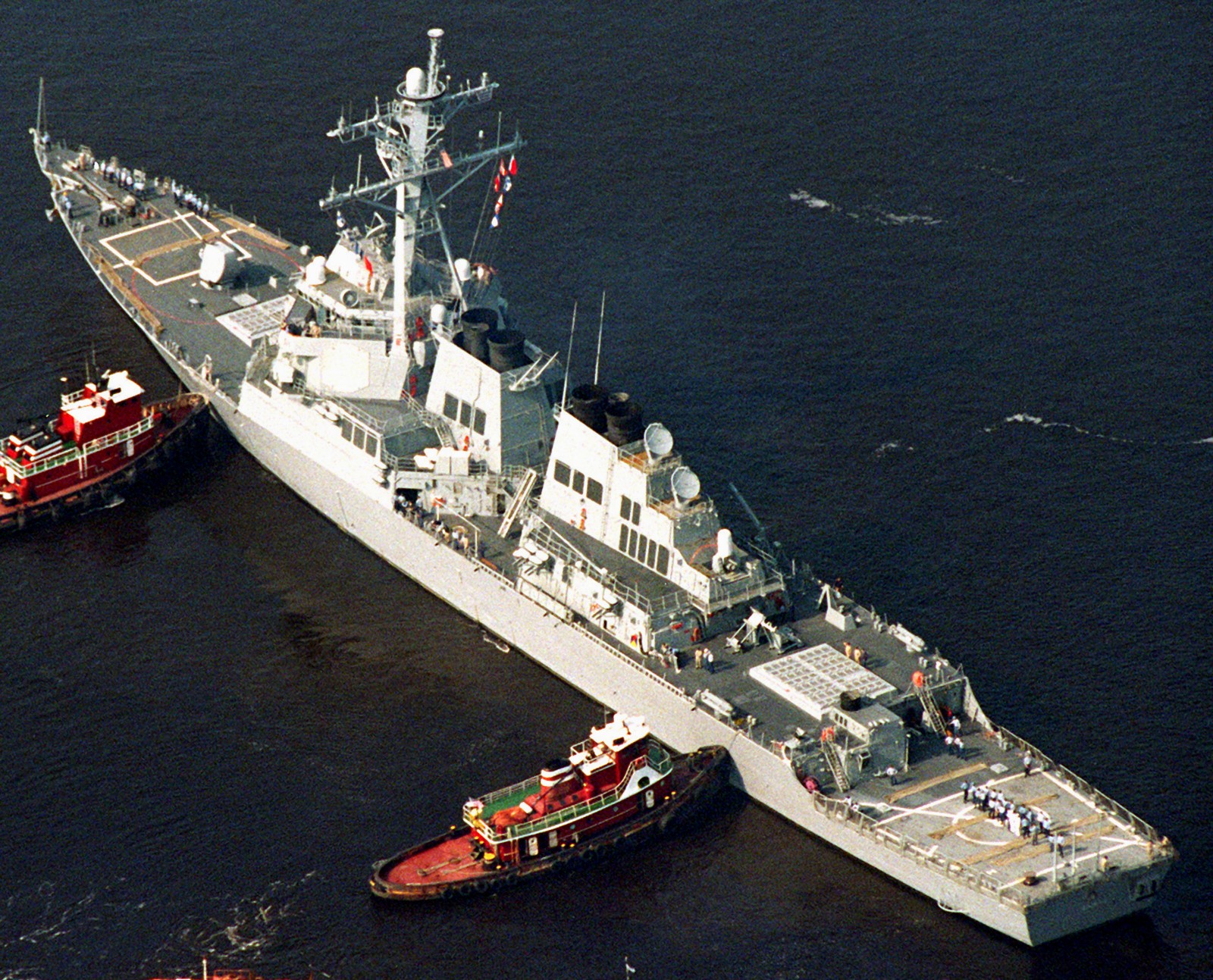 Norfolk, Virginia - October 1996  sea trials - May 1996  sea trials - May 1996  sea trials - May 1996  sea trials - May 1996  sea trials - May 1996 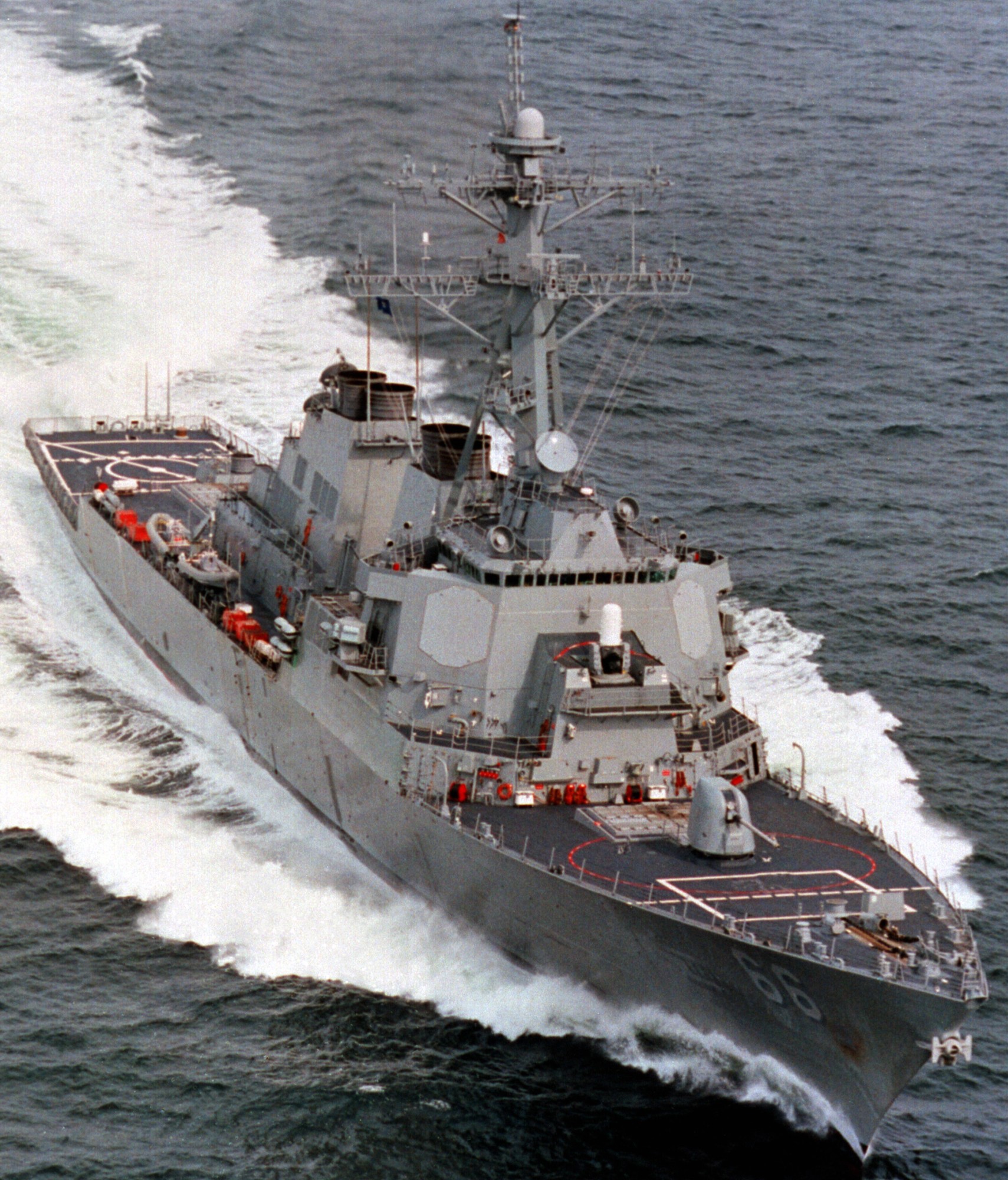 sea trials - May 1996 
 sea trials - May 1996  sea trials - May 1996  sea trials - May 1996  sea trials - May 1996  sea trials - May 1996  sea trials - May 1996  sea trials - May 1996  sea trials - May 1996 |
||
|
USS Gonzalez (DDG 66): 12 - 31 October 1996: Guided missile destroyer Gonzalez (DDG-66) was commissioned on 12 October 1996 at Ingelside, TX with Commander (CDR) Frederick D. Allard in command. She is equipped to operate offensively in a high-density, multi-threat environment as an integral member of a carrier battle group or surface action group. In this capacity, she is capable of executing anti-air, anti-submarine, and anti-surface warfare. Ingelside, TX is not far from the boyhood home of Alfredo Gonzalez, the ship's namesake who inspired her motto, "Beyond the Call," through his selfless actions to protect the men in his platoon and to defend the United States in time of war. With nearly seven thousand family, friends, comrades, and community members in attendance, Mrs. Dolia Gonzalez, Alfredo's mother, ordered the crew to "bring their ship to life." Flying her newly raised commissioning pennant, Gonzalez remained at Ingelside, hosting the public through the 15th. She then steamed for Port Canaveral, FL where she completed her anti-submarine capability evaluation from 17-22 October. 1 Nov - 1 Dec 1996: After sailing to the Atlantic Undersea Testing and Evaluation Center (AUTEC) Operating Area in early November for submarine tracking and attack scenarios, Gonzalez continued her Combat Systems Qualification and Testing while conducting a shakedown cruise through the West Indies, calling at Philipsburg, St. Maartin from 8-12 November. Gonzalez was outbound from St. Maartin on the 12th, when at 0800, she ran aground on a coral reef, severely damaging several blades on both propellers as well as the sonar dome on the underside of her hull. After clearing herself of the reef, Gonzalez limped to Roosevelt Roads, Puerto Rico where an investigation into the incident, directed by Commander, Destroyer Squadron (ComDesRon) 26, determined the accident "to have been avoidable," placing blame on the CO, Officer of the Deck (OOD), and Navigator. Consequently, CDR Allard was relieved of command by CDR Daniel P. Holloway on 21 November while the ship remained in Roosevelt Roads. A survey of the hull found the damage to be severe enough to necessitate a significant overhaul which could not be accomplished with the limited facilities at Roosevelt Roads. Consequently, Gonzalez was towed by fleet ocean tug Apache (ATF-172) for the voyage to Norfolk, VA where the duo arrived on 1 December 1996. This proved to be an inauspicious inaugural arrival to her homeport. Despite the circumstances, many of Gonzalez' crew were happy to have returned to Norfolk for the holiday season since some had not seen their loved ones in over eight months. January - September 1997: After bringing in the new year, Gonzalez was again under tow, this time from Norfolk to the Bath Iron Works, Portland, ME, arriving on 15 January 1997 for a nine-months of drydock repair and post-shakedown modernization. October 1997 - 10 April 1998: The new year found Gonzalez preparing to commence trials and qualifications after the previous year's period of maintenance. On 12 January, Gonzalez steamed from Norfolk enroute to Fort Lauderdale, FL, commencing a year in which she successfully passed all trials and tests as well as completed her Inter-Deployment Training Cycle (IDTC). While much of the crew enjoyed liberty, the ship continued to be prepared for its Post-Delivery Tests and Trials which included an underwater inspection of the ship's hull and sonar dome in order to be certain that the damage sustained from the reef had been satisfactorily remedied. After a port visit to Fort Lauderdale, Gonzalez steamed for the Puerto Rican Operating Area and AUTEC where the bearing and range accuracy of her sonar was tested. On 24 January, she pulled into Roosevelt Roads and embarked the technical personnel who would be administering and supervising the final tests. Over the course of the next few weeks, Gonzalez conducted various tests and exercises involving her engineering system and live fire of her weapons system. She returned to Norfolk on 13 February, having completed the first phase of her Basic Training Cycle. The second phase involved Cruise Missile Tactical Qualification, a Logistics Management Assessment, and the "most challenging" hurdle, the Engineering Certification. On 16 March, Gonzalez steamed from Norfolk to the Virginia Capes Operating Area (VCOA) with a full complement of inspectors to carry out these inspections, which she passed with flying colors. She returned to sea once again on 23 March for the third phase of the training cycle. While undergoing this phase, Gonzalez had the opportunity to join aircraft carrier Enterprise's (CVN-65) Battle Group, which included the rest of Destroyer Squadron (DesRon) 18, for an Over-the-Horizon Targeting Exercise during which Gonzalez remained undetected to the rest of the force and, as a result, was able to "sink" guided missile cruiser Gettysburg (CG-64) and destroyer Nicholson (DD-982). On 27 March, Gonzalez returned to Norfolk, "having passed another hurdle on the long road to deployment." From 1-10 April, she was once again at sea, this time to complete her Final Contract Trials (FCT) and her Board of Inspection and Survey (InSurv). During this time, inspectors scoured the ship "from stem to stern" to insure that she was in "peak condition." The combined FCT/InSurv made certain that the work contracted and paid for by the Navy Department met the expectations and specifications to make Gonzalez an effective asset of the fleet and to determine whether or not she met material and readiness standards. She completed the Final Evaluation Problem (FEP), marking the end of her basic training period which had been made "more arduous" by the unfinished trials that had to be completed simultaneously as a result of the 12 November 1996 accident. 11 April 1998 - 27 December 1998: The summer was passed undergoing the usual training and briefing cycle that ultimately prepared the ship for overseas deployment. Meanwhile, work was done to bring Gonzalez to the cutting edge of information technology with the installation of Integrated Technology for the Twenty First Century (IT-21) which allowed message traffic not classified as Secret to be viewed by the officers and crew at a number of work stations throughout the ship. In addition, the new technology brought email and internet access to the crew, helping them to stay in closer contact with family and friends as well as going a long way to ameliorate the feeling of isolation that so often characterizes life at sea, far from home. As Gonzalez' Command History Report (CHR) observes, "the IT-21 installation was one of the biggest improvements to the officers' and crew's quality of life." In early July, Gonzalez sailed for the Virginia Capes where she participated in Exercise Vandal which included operations with five other guided missile destroyers, returning to Norfolk on 9 July. On the 10th, CDR Joseph W. Murphy became Gonzalez' new skipper as he relieved CDR Holloway. Gonzalez steamed from Norfolk on 24 July with the other ships of DesRon 18 bound for the Puerto Rican Operating Area and operations with Enterprise's Battle Group. The emphasis of the exercise would be coordinating operations, culminating in the Intermediate Training Assessment, a three day mock war with Enterprise's Battle Group opposed by the ships of DesRon 18 as well as submarines and aircraft. Gonzalez and the rest of her Blue Force cohorts emerged victorious from the simulation on 19 August, returning to Norfolk on the 21st. All this training built to the Joint Task Force Exercise (JTFEX) which would bring the IDTC to a close. The JTFEX was Gonzalez' "last opportunity to prepare itself for the 'real world' operations in the Mediterranean and Arabian Sea." The exercise again involved a joint battle scenario, during which she performed escort duties for amphibious assault ship Nassau's (LHA-4) Amphibious Ready Group from 18 September - 5 October. Gonzalez returned to Norfolk on 6 October to commence her Final Maintenance Availability (FMAV) which prepared her for the upcoming deployment. She was underway briefly on 6 November, escorting Enterprise's Battle Group to sea in company with Nicholas. On the evening of 8 November, while Enterprise was conducting night landing qualifications, two of her aircraft collided on approach to the carrier. Gonzalez aided in the two day search and rescue effort to locate the four missing airmen. As Enterprise and her battle group continued across the Atlantic, Gonzalez detached for a three day port visit to Baltimore, MD before returning to Norfolk for ammunition onload and final deployment preparations. 28 December 1998 - 25 June 1999: After celebrating the Christmas holiday at Norfolk, Gonzalez sailed for the Mediterranean on 28 December, commencing her first overseas deployment as part of Task Force (TF) 99-1. The TF consisted Enterprise's Battle Group and Nassau's Amphibious Ready Group and was tasked with monitoring the situation in the former Yugoslavia and enforcing UN sanctions on Iraq. After transiting the "choppy, savage" Atlantic, Gonzalez arrived at Gibralter for a brief port visit before entering the Mediterranean. At Gibralter, the crew enjoyed the exotic cuisine that characterizes that part of the world in which a variety of cultures converge; some of the crew "enjoyed spicy food at Casapepe's," while some "relished a corned-beef sandwich washed down with a cold stein of hard cider at the Angry Friar." The crew, however, could not ignore their American palate. As Gonzalez pulled into Naples, the crew rejoiced at the thought of American food..."the NEX, commissary, Wendy's, Subway...fast food finally!!" In March, Enterprise's Battle Group continued into the Persian Gulf while Gonzalez steamed into the Adriatic Sea for Operation Allied Force, a NATO operation to defend Kosovar Albanians against the aggression of Serbian President Slobodan Milosevic. This was to be accomplished by striking Serbian military infrastructure in a series of airstrikes and missile attacks, including a total of 43 Tomahawk Cruise Missiles fired from the deck of Gonzalez. NATO operations against Serbia were wrapped up in June as Milosevic agreed to pull forces out of Kosovo. This ended a highly successful operation in which NATO forces achieved their goals while suffering no combat fatalities and negating the use of ground forces. Gonzalez continued to operate in the Mediterranean in early June, calling at Haifa, Israel; Cannes, France; and Malaga, Spain before returning to Norfolk on 25 June. On the last day of Gonzalez' maiden deployment, the crew was brimming with the anticipation of returning home. The ship's deck log stated, "reveille never sounded so good, with only a few hours away from home the crew was exploding with excitement." July 1999 - March 2000: Following a leave and upkeep period, Gonzalez, began a long series of inspections and training evolutions at sea. The routine was broken by occassional highlights, such as the "fierce January weather" encountered while off the Virginia Capes in early 2000. The storm tested the stomachs of even the most experienced blue jacket as a "nasty Nor'easter" tossed the destroyer about. Another break occured in March when Gonzalez steamed south to Savannah, GA to help that city celebrate St. Patrick's Day. April - December 2000: Gonzalez was at sea once more in early April, this time in company with other ships of DesRon 18 to participate in NATO Exercise Linked Seas off the coast of Portugal. After a ten day Atlantic transit, Gonzalez arrived off Portsmouth, UK on 19 April from whence many of her crew embarked on a trip to London. Business resumed on 1 May for the NATO exercise which involved naval forces from over thirty NATO and Partnership for Peace nations. Over the course of operations the "tempo never waned," as all combat areas, from undersea warfare to air defense, were tested. The tasks developed in complexity and force size, finally culminating in a full-scale battle scenario involving over eighty surface units. The exercise concluded on 15 May and Gonzalez returned to Norfolk along with the other ships of DesRon 18. After a month in port punctuated with a brief cruise off the Virginia Capes, Gonzalez departed Norfolk in company with guided missile destroyer Stout (DDG-55) on 5 July, bound for Halifax, Nova Scotia where the duo arrived on the 7th. The crew enjoyed four days in "the beautiful Canadian port city" before departing on 11 July. The remaining summer months were passed preparing the ship for operations in the fall. Gonzalez joined the Enterprise Battle Group on 16 September for a Group Sail during which the highlight was a check of the destroyer's AEGIS weapons system by engaging a supersonic test target with a Standard Missile. Gonzalez completed this successfully and returned to port on 29 September. On 16 October she rendered her services as part of the opposing force for aircraft carrier Harry S. Truman's (CVN-75) Battle Group during their JTFEx. During this time, Gonzalez particularly impressed Vice Admiral (VADM) Mullen, ComSecondFlt with her ability to respond with flexibility to an ever changing tactical environment. She returned to Norfolk on 26 October, where she remained until 13 November when she met Enterprise's Battle Group for another Group Sail. Gonzalez returned to Norfolk on the 17th, fully expecting to remain there for the holiday season. These hopes did not come to pass. On 7 December, she was ordered to steam to the Puerto Rican Operating Area where she conducted Naval Surface Fire Support qualifications, scoring highly on the drill. On 15 December, she arrived back in Norfolk to commence her holiday stand down. January - April 2001: Gonzalez spent early 2001 continuing to make preparations for deployment and to bring the readiness of both ship and crew up to its highest possible level. This was accomplished via a pair of Composite Unit Training Exercises (CompTUEx) held throughout January and February. In March, she participated in a JTFEx before operating with the rest of DesRon 18 in further training exercises. 25 April 2001 - 25 October 2001: Gonzalez departed Norfolk with DesRon 18 and Enterprise's Battle Group on 25 April bound for the Mediterranean Sea. Enroute, the squadron participated in a number of exercises and drills intended to hone the ships' skill in undersea warfare. Soon after transiting the Atlantic, Gonzalez detached from this force and rendezvoused with six other NATO ships each from a different foreign navy to comprise Surface Naval Forces Mediterranean (SNFM). The force called at Valencia, Spain on 9 May and proceeded to conduct a number of drills while enroute to Toulon, France where the SNFM arrived on 16 May. While at that port, a change of command ceremony was conducted (22 May) aboard Gonzalez in which the crew bade farewell to CDR O'Rourke and welcomed CDR Andrew A. King as the ship's new CO. The SNFM departed Toulon on the 22nd anticipating Exercises Trident D'Or (25 May - 1 June) and Cooperative Partner (10-22 June). These were intended to test and develop skills in divisional tactics, gunnery, anti-submarine warfare (ASW), air defense, and communications as well as to foster greater integration and cohesion in operations with the foreign navies of Great Britain, Spain, Germany, Turkey, Greece, and Italy. In seeking to achieve the latter, American crews swapped ships and duties with their counterparts from those nations, promoting "cultural exchange" and familiarity with "the daily routine of their European counterparts." In July, the SNFM operated in the Eastern Mediterranean, the Black Sea, and the Aegean Sea, carrying out various exercises which "offered sailors a chance to enhance diplomatic ties...but also added to the burgeoning relationships that were being formed with fellow SNFM sailors." The end of July marked the halfway point of the deployment and the ships of the force dispersed for Independent Steaming Exercises (ISEs). Thenceforth, Gonzalez steamed throughout the Mediterranean making port visits at Trieste and Gaeta, Italy, Marseilles, France, and Malaga, Spain all the while continuing to drill and exercise to maintain Gonzalez' operational readiness. She rejoined the SNFM on 3 September, although new ships had relieved the ones with which Gonzalez had operated earlier in the deployment. While moored at Plymouth, England on 11 September, Gonzalez made an emergency sortie in response to the terrorist attacks in New York City and Washington, D.C. Some measure of the camraderie that developed between the USN and the navies of her fellow NATO allies is evidenced by the behavior of the German destroyer Lutjens who steamed past Gonzalez and guided missile destroyer Winston S. Churchill (DDG-81), raising the American flag to half-mast and displaying a banner declaring, "We Stand By You." After the 11 September attacks, Gonzalez stepped up her operational tempo, conducting exercises that would prepare her to respond to a broad range of contingencies. She joined up with guided missile destroyer Stout (DDG-55), and destroyers Nicholson (DD-92) and Thorn (DD-98) of DesRon 18 on 5 October and after a brief stop in Rota, Spain, commenced the transatlantic voyage. She arrived back in Norfolk on 25 October and began a period of leave and upkeep. 25 October 2001 - 31 December 2002: Before year's end, Gonzalez sailed once more, this time on a Group Sail with DesRon 18 off the Virginia Capes. From 4-7 December, the squadron conducted divisional tactics and other group exercises before returning to Norfolk to celebrate the holiday season. In early 2002, Gonzalez once again commenced the cycle of Interdeployment exercises that would culminate in her next deployment. From 8-11 January, she executed ASW exercises off the coast of Rhode Island and participated in JTFEx 02-1 in the VCOA in February. On 15 February, Gonzalez returned to Norfolk for a period of intensive maintenance during which upgrades to her combat systems' capabilities were installed. The upgrades included the Advanced Tomahawk Weapons Control System. In March, Gonzalez commenced a period of Restricted Maintenance Available while her crew went to work on a comprehensive industrial package. By the time of Light-off Assessment (28-30 May) the crew had resurfaced the deck and cleaned the underwater hull. June was spent preparing for upcoming assessments and certification of her new combat system upgrade. This certification was successfully passed in July after which the crew shifted focus toward preparing for the ships InSurv inspection. Refresher training was conducted while enroute to the Bahamas (26-29 August) and "honed watchstanders' warfighting and damage control skills." Preparation for InSurv continued through September. The assessment was successfully completed from 7-11 October in the VCOA after which Gonzalez steamed to Mayport, FL to continue refresher training. November and December were busily spent inport conducting inspections and preparations for the ship's FEP. This was completed after the Thanksgiving holiday (3-6 December) and marked Gonzalez' transition to the advanced phase of her IDTC. The year was concluded with a change of command ceremony in which CDR Karl J. Van Deusen became Gonzalez' new skipper, relieving CDR King on 13 December. No command history 2003 29 November 2003 - April 2004: Gonzalez got underway in company with Cole (DDG-67) and Thorn (DD-988) in a three-ship Surface Strike Group (SSG) at the end of November, arriving in the Mediterranean in mid-December. From 19-22 April, Gonzalez participated in multilateral maritime interdiction training Exercise Clever Sentinel 04 with ships from the Italian, French, Spanish, and Dutch navies as well as container ship Eugene A. Obregon (T-AK 3006) and an American P-3C surveillance aircraft operating out of Sicily. The exercise was part of American President George W. Bush's Proliferation Security Initiative under which participating nations could disrupt illegal trade in Weapons of Mass Destruction by searching ships and aircraft suspected of carrying such weapons. Gonzalez returned to Norfolk on 28 May. October 2004 - March 2005: Gonzalez commenced the Navy's second experimental Sea Swap, and the first such such program to occur in the Atlantic Fleet. The swap was planned for three, six month phases during which Gonzalez remained on station for eighteen continuous months and was manned by three different crews, first from guided missile destroyers Laboon (DDG-58) and Stout (DDG-55), and then the original complement from Gonzalez. Gonzalez was chosen, according to Captain (CPTN) Pat Allen, Deputy Chief of Staff for Commander, Naval Forces Atlantic, because she was equipped with "the largest set of command and control capabilities in support of the expeditionary strike group that it's going to deploy with." Under the Sea Swap program, a ship can remain at sea for up to twenty four months while crews from similar types of ships deploy aboard for six month periods, thereby maximizing on-station time and minimizing extensive cruising to and from the US. Laboon's crew came aboard Gonzalez on 22 October to complete final pre-deployment certifications and to get acclimated to the new ship. They remained aboard through the close of the year. In the new year, Laboon's crew (now designated DDG Crew Lima) continued to ready Gonzalez for the upcoming deployment. She steamed from Norfolk on 10 January with amphibious assault dock Kearsarge (LHD-3), participating in an Expeditionary Strike Group Exercise (ESGEX) through the 19th in the Cherry Point OPAREA. February and March were passed in a number of exercises as well as maintenance while the crew enjoyed leave (26 February - 20 March). 25 March 2005 - 18 September 2005: Gonzalez departed Norfolk on 25 March bound for the Mediterranean and eighteen continuous months at sea. She did so in concert with amphibious assault dock Kearsarge's Expeditionary Strike Group (ESG). Before reaching Gibralter, she participated in Exercise Barbary Thunder with ships of the Royal Moroccan Navy. This exercise honed the crew's skill in formation maneuvering, search and rescue, and over-the-horizon targeting. Thence, she sailed east in the Mediterranean, commencing Exercise Caya Green with ships of the Israeli navy. This exercise focused on ASW with Gonzalez assuming Tactical Command responsibilities. At the conclusion of this exercise, Gonzalez set course for the Persian Gulf, transiting the Suez Canal on 22 April and inchopping to US Fifth Fleet where she would support coalition operations as part of Operation Iraqi Freedom and the ongoing Global War on Terror. Enroute, Gonzalez aided a Pakistani fishing dhow on 10 May whose disabled engine had left her adrift in the Gulf of Oman and reliant on a makeshift bedsheet as her motive power. The destroyer evacuated the crew and took the boat in tow, steaming for Pakistani coastal waters where the boat was handed over to Pakistani frigate Tariq. Off the coast of the United Arab Emirates, Gonzalez participated in Exercise Iron Siren 2005, a multinational exercise with ships from the United Kingdom and United Arab Emirates (21-24 May). The exercise concentrated on mastery of small boat attack defense (a tactic increasingly favored by terrorists), oil platform defense, gunnery exercise coordination, and boarding/search and seizure operations. In June, Gonzalez maintained a steady presence off the coast of the Arabian Peninsula conducting a number of Maritime Interdiction Operations (MIO) designed to deny terrorists the use of international waters. In these operations, the crew's training which had been "conducted months prior to arrival in the operational area was put to use immediately." A different scenario developed on 6 June when Gonzalez received a distress call from motor vessel Tigris which had come under assault from pirates off the coast of Somalia. The destroyer set course for the troubled vessel, steaming at full speed. She arrived on scene with .50 caliber machine guns firing warning shots and used her search lights and flares to illuminate the pirates who apparently decided that they were no match for an American guided missile destroyer and hastily fled the scene of action. On 6 July, Gonzalez called at Mombasa, Kenya for a two day port visit which was the first by a US Navy vessel since 1999. The visit was a diplomatic success with Mombasa's mayor acknowledging the favorable "signal [the Gonzalez visit] sends to us as a country." Departing Mombasa, Gonzalez continued her MIO mission through September. On 18 September she arrived at Jebel Ali, United Arab Emirates, where Crew Lima departed Gonzalez in order to make room for a new crew, originally from guided destroyer Stout (DDG-55), as part of the second phase of the Sea Swap program. 18 September 2005 - 21 February 2006: Stout's crew, designated Crew Sierra, quickly and smoothly assumed responsibility for Gonzalez with CDR Jack Noel newly in command. On 23 September, with the Sea Swap complete, Gonzalez joined ESG 1 which consisted of amphibious assault ship Tarawa (LHA-1), amphibious transport dock Cleveland (LPD-7), dock landing ship Pearl Harbor (LSD-52), guided missile cruiser Chosin (CG-65), guided missile frigate Ingraham (FFG-61) and submarine Santa Fe (SSN-763). While steaming off the coast of Egypt, the force participated in Exercise Bright Star on 23 and 29 September along with ships of the Pakistani, Italian, and Egyptian navies. The exercise focused on Maritime Security Operations, the very same duties Gonzalez had been experiencing during the previous six months, albeit with a different crew. The task, however, was more international in scope as Americans worked side by side with Pakistanis (hand signals were used for communication) to successfully carry out the Visit, Board, Search and Seizure (VBSS) operations. Bright Star concluded operations in the Mediterranean and ESG 1 steamed into Fifth Fleet Area of Responsibility (AOR) via a southbound transit of the Suez Canal on 1 October. Throughout October and November, Gonzalez carried out MIO duties in the Gulf of Aden, Horn of Africa, Arabian Sea, and Gulf of Oman. She also conducted escort duties for Tarawa, Cleveland, and Pearl Harbor in the Persian Gulf as the trio disembarked the 13th MEU for ground operations in support of Operation Iraqi Freedom. November found Gonzalez cruising in the Indian Ocean off the east coast of Africa bound for the Seychelles Island chain. Explosive Ordinance Disposal (EOD) Mobile Unit 8 (Det. 4) preceded her, sweeping the port for possible mines. On the 5th, pirates armed with RPGs and AK-47s attacked the cruise ship Seabourn Spirit carrying 312 passengers and crew off the coast of Somalia. The ship suffered minor damage and the EOD unit, already in the area for Gonzalez, boarded the cruise ship to investigate an unexploded RPG fragment. Through the end of the year Gonzalez continued her MSO/MIO mission, operating in the US Naval Forces Central Command AOR with the Dutch-led Combined Task Force (CTF) 150, the American led CTF 152, and the British-led TF 58. On 12 January, Tarawa's ESG 1 departed the Fifth Fleet AOR enroute to their home port of San Diego. Gonzalez again remained behind in anticipation of the third phase of the Sea Swap program. She steamed for Manama, Bahrain to receive her third crew while forward deployed in the Middle East. 21 February 2006 - 13 July 2006: A homecoming of sorts occurred on 21 February 2006 when Gonzalez' original crew (designated Crew Golf), relieved Crew Sierra, commencing the third and final phase of the Sea Swap. CDR Robert Randall became the ship's new skipper, while CDR Noel and Crew Sierra looked forward to an extended liberty before returning to the US. Gonzalez again assumed MIO duties in the Indian Ocean, supporting freedom of navigation through a region that is not only an important commercial crossroads, but has been plagued by a growing incidence of seaborne piracy. In March, Gonzalez was patrolling in the Persian Gulf when she spotted a crippled Iranian fishing dhow in need of assistance. Gonzalez rescued the crew who explained that their ship had been adrift since 18 February when the boat's engine and rudder had failed. Gonzalez provided the mariners with food and water and her engineering department determined that the boat's engine was irreparable. Consequently, Gonzalez arranged the crew's safe passage back to Iran via other coalition warships. On 18 March, while operating off the coast of Somalia in company with guided missile cruiser Cape St. George (CG-71), Gonzalez spotted two skiffs towed by a larger forty foot diesel boat and dispatched two Rigid Hull Inflatable Boats (RHIB) to board the suspicious vessels. When the boats came alongside, the pirates opened fire. Gonzalez and Cape St. George responded by spraying the boats with machine gun fire, covering the boarding parties as they hurriedly returned to the safety of Gonzalez. In the midst of the action, machine gun fire from Gonzalez ignited a 55-gallon fuel drum aboard the larger boat, racking the ship with explosions and sending billowing black smoke high into the air. The action killed one Somali pirate and wounded five. Gonzalez and Cape St. George captured twelve and treated the injured. A number of the Somali pirates' RPGs and automatic weapons were confiscated from the ships. In early April, Gonzalez rendezvoused with a new ESG centered around the amphibious assault ship Peleliu (LHA-5) and consisting of landing dock Germantown (LSD-42), transport dock Ogden (LPD-5), guided missile cruiser Port Royal (CG-73), and guided missile frigate Reuben James (FFG-57). ESG 3 embarked the 11th MEU in support of Operation Iraqi Freedom and Operation Enduring Freedom. Gonzalez continued MIO operations through the spring, maintaining freedom of the seas and monitoring the critical choke points of the 5th Fleet AOR which includes the Suez Canal, the Strait of Hormuz, and the Strait of Bab al Mandeb. ESG 3 wrapped up its deployment on 9 July and steamed east bound for Pearl Harbor and San Diego. Gonzalez' forward deployment was also scheduled to end and so she steamed west through the Suez Canal and into the Mediterranean bound for Norfolk after seventeen consecutive months at sea. This, the second experimental Sea Swap executed by the US Navy, turned out to be more successful than the first with high crew morale and efficient crew swapping among Gonzalez and her sisters Laboon and Stout. Nevertheless, the program proved to be too complex to be effective on the Navy's 62 Arleigh Burke class guided missile destroyers, but may still hold future promise for smaller ships with crew complements of fewer than one hundred. July 2006 - August 2006: Gonzalez' return to Norfolk, however, would have to wait due to a new eruption in the ongoing Arab-Israeli conflict that endangered American lives in Lebanon. In July 2006, reacting to an already intensified situation in Gaza and the capture of two Israeli soldiers by the Lebanon-based terrorist group Hezbollah, Israel launched air attacks against Lebanon, endangering the lives of 25,000 American citizens living in that country. At the request of the US Ambassador to Lebanon, the Department of Defense dispatched American naval forces to the area in order to prepare for the possible evacuation of these expatriots. Gonzalez was one of the first on the scene, escorting contracted cruise ship Orient Queen in the initial evacuation of expatriots to Cyprus. Gonzalez was later joined in the Mediterranean by guided missile destroyer Barry (DDG-52) and amphibious assault ship Iwo Jima's Expeditionary Strike Group, consisting of Iwo Jima (LHD-7), dock landing ship Whidbey Island (LSD-41), and transport dock Nashville (LPD-13), with the 24th MEU embarked. These ships formed Task Force 59 under the command of Brigadier General Carl Jensen and were charged with evacuating and protecting Americans in Lebanon. Over the course of operations, some 14,000 American citizens were safely evacuated from Tyre and Beirut. 2006-2007 After a long, 18 month deployment, GONZALEZ completed a much need dry-dock availability, following which the ship performed very well during the critical, 5-year Board of Inspection and Survey (INSURV) inspection. 2008 After a demanding training cycle, GONZALEZ returned again to the 6th Fleet Area of Operations in the Mediterranean on 19 February 2008, as an independent deployer serving as the Air Defense Commander for Standing NATO Maritime Group Two. Since deploying, the GONZALEZ crew has enjoyed port calls in Rota, Spain; Aksaz, Turkey; Antalya, Turkey; Volos, Greece; Haifa, Israel; Trieste, Italy; Koper, Slovenia; and Palermo, Sicily. She participated in Exercise Mavi Balina 2008 and in several multi-national PASSEX operations. Home Port Assignments: Norfolk, Virginia Squadron Assignments: DesRon 20 (12 October 1996) DesRon 18 (1 February 1998) Commanding Officers: CDR Frederick D. Allard (13 September 1996) CDR Daniel P. Holloway (21 November 1996) CDR Joseph W. Murphy (10 July 1998) CDR Patrick E. O'Rourke (14 January 2000) CDR Andrew A. King (22 May 2001) CDR Karl A. Van Deusen (13 December 2002) Probably Missing CO Here CDR Jeffrey T. Griffin (22 October 2004) CDR Jack Noel (September 2004) CDR Robert D. Randall (21 February 2006) Changes in armament and major systems (Weapons and radar/sonar equipment): Advanced Tomahawk Weapons Control System (installed February 2002) Major Overseas Deployments (or deployments away from home port for more than 2 months): 28 December 1998 - 25 June 1999, Mediterranean Theater 25 April 2001 - 25 October 2001, Mediterranean Theater Probably missing a 2003 deployment Missing a 2004 deployment, Mediterranean Theater 25 March 2005 - 18 September 2005, Mediterranean and Middle East Theaters September 2005 - 21 February 2006, WestPac and Indian Ocean Theaters 21 February 2006 - 1 August 2006, Middle East and Mediterranean Theatre Unit Awards Received: Navy E Ribbon (NE), 1 January 1999 - 31 December 1999 Navy E Ribbon (NE), 1 January 2001 - 31 December 2001 source: US Naval History & Heritage Command |
||
|
Sergeant Alfredo Cantu Gonzalez (May 23, 1946 - February 4,
1968): Alfredo "Freddy" Gonzalez was born on 23 May 1946 in Edinburg, Texas. After graduating from Edinburg High School he enlisted in the Marine Corps in the summer of 1965 and was sent to Vietnam where he completed one tour of duty and was promoted to the rank of Sergeant (SGT). Gonzalez returned to Vietnam for a second tour as platoon sergeant, 3rd Platoon, Company A, First Battalion, 1st Marine Regiment where, on 31 January 1968, Gonzalez' unit participated in the initial phase of the Battle of Hue, the American effort to retake Vietnam's ancient imperial capital which had been overrun by North Vietnamese forces during the Tet Offensive. After providing cover fire for American tanks crossing the Loi Nong River and executing a search and destroy mission near Highway 1, the company experienced heavy fire from enemy automatic weapons and rockets. SGT Gonzalez received fragmentation wounds as he ran through withering enemy fire to rescue an injured marine lying in the open field. When a medic offered to treat his wounds, Gonzalez responded, "I have to keep the guys moving, or we'll never get out of here." Despite the injury, he led his platoon to a position behind a dike on the edge of a rice paddy where his men were protected from enemy fire and had a clear line of fire to the enemy positions. To take the heat off his comrades, Gonzalez ordered them to put covering fire on a bunker to the west of their position while he took off toward the emplacement. With complete disregard for his own well-being, Gonzalez single-handedly neutralized the bunker using four hand grenades. On 3 February, he was wounded once more, this time by enemy sixty millimeter mortar fire to both arms and his left leg, but again he disregarded medical attention, preferring to lead his platoon into battle. On 4 February, Gonzalez' platoon was in the point position when a firefight commenced in the vicinity of Hue's Jeanne d'Arc school. The numerically superior enemy again kept the platoon pinned down while maintaining an intense fire on Gonzalez' position and threatening to push the platoon back. Once more, at the risk of his own life, Gonzalez moved from position to position, all the while firing rounds at various enemy positions. He silenced much of the enemy fire and knocked out a rocket position before falling mortally wounded. As the medic administered to the dying sergeant, Gonzalez could only think of his men's safety, pleading, "Doc, keep those men firing, it's their only chance." He was twenty two years old. For his "great courage, and dynamic leadership" in the line of duty, SGT Gonzalez was posthumously awarded the Medal of Honor. Medal of Honor citation: For conspicuous gallantry and intrepidity at the risk of his life above and beyond the call of duty while serving as Platoon Commander, Third Platoon, Company A, First Battalion, First Marines, First Marine Division, in the Republic of Vietnam. On 31 January 1968, during the initial phase of Operation HUE CITY Sergeant Gonzalez' unit was formed as a reaction force and deployed to Hue to relieve the pressure on the beleaguered city. While moving by truck convoy along Route #1, near the village of Lang Van Lrong, the Marines received a heavy volume of enemy fire. Sergeant Gonzalez aggressively maneuvered the Marines in his platoon, and directed their fire until the area was cleared of snipers. Immediately after crossing a river south of Hue, the column was again hit by intense enemy fire. One of the Marines on top of a tank was wounded and fell to the ground in an exposed position. With complete disregard for his own safety, Sergeant Gonzalez ran through the fire-swept area to the assistance of his injured comrade. He lifted him up and though receiving fragmentation wounds during the rescue, he carried the wounded Marine to a covered position for treatment. Due to the increased volume and accuracy of enemy fire from a fortified machine gun bunker on the side of the road, the company was temporarily halted. Realizing the gravity of the situation, Sergeant Gonzalez exposed himself to the enemy fire and moved his platoon along the east side of a bordering rice paddy to a dike directly across from the bunker. Though fully aware of the danger involved, he moved to the fire-swept road and destroyed the hostile position with hand grenades. Although seriously wounded again on 3 February, he steadfastly refused medical treatment and continued to supervise his men and lead the attack. On 4 February, the enemy had again pinned the company down, inflicting heavy casualties with automatic weapons and rocket fire. Sergeant Gonzalez, utilizing a number of light antitank assault weapons, fearlessly moved from position to position firing numerous rounds at the heavily fortified enemy emplacements. He successfully knocked out a rocket position and suppressed much of the enemy fire before falling mortally wounded. The heroism, courage, and dynamic leadership displayed by Sergeant Gonzalez reflected great credit upon himself and the Marine Corps and were in keeping with the highest traditions of the United States Naval Service. He gallantly gave his life for his country.
|
||
| patches + more | ||
 
  |
||
|
|
seaforces.org |
USN ships
start page | |

